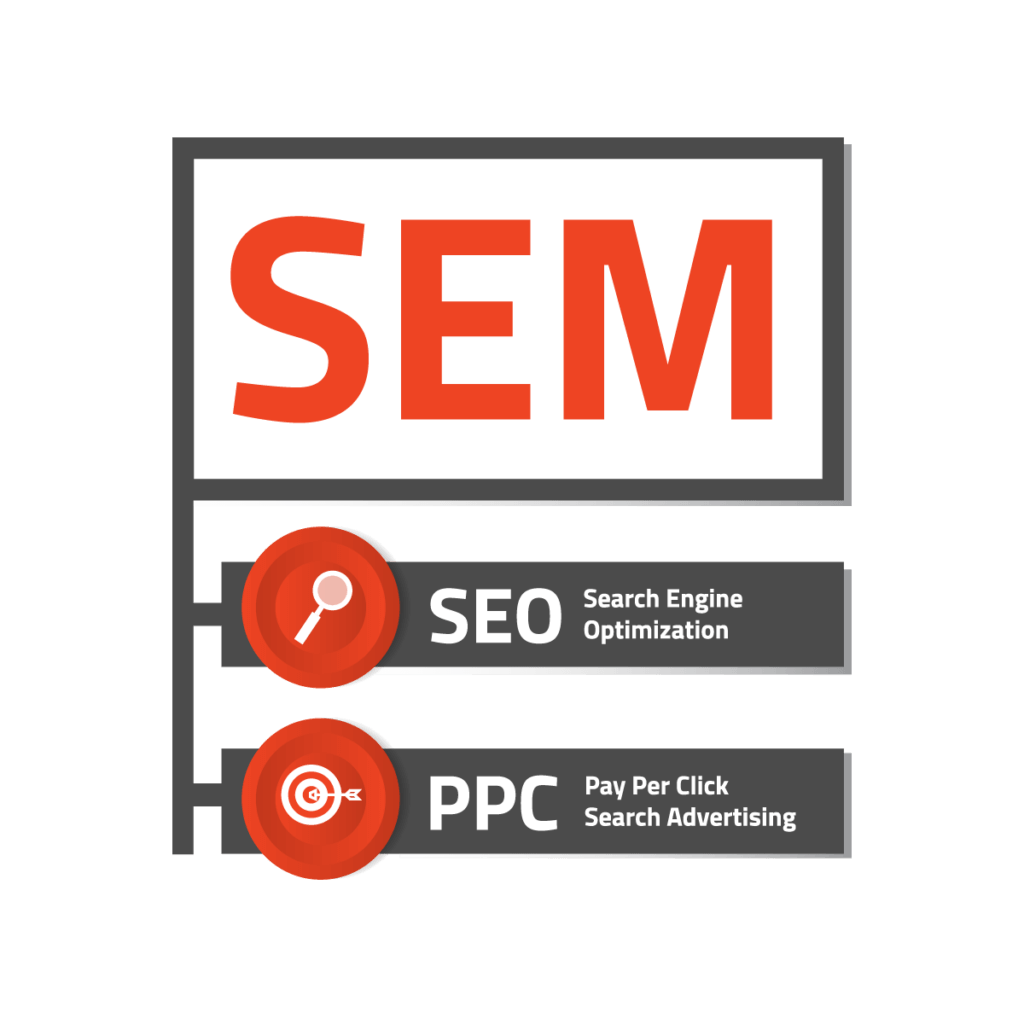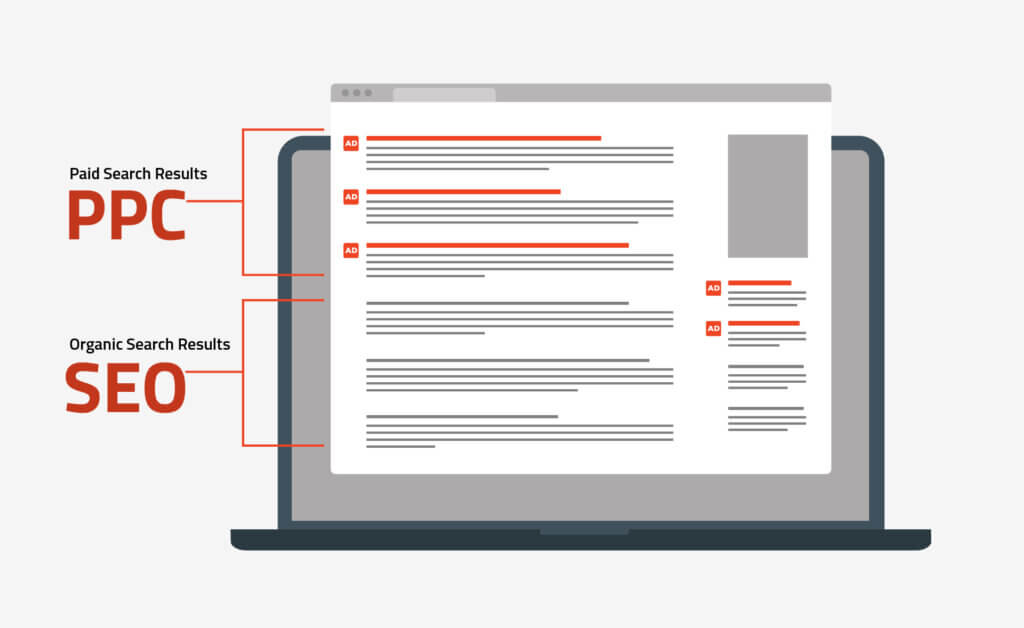How do you get eyes on your business site? It often begins with a search. And that’s where SEO vs SEM comes into play.
Whether it’s a quick search for a “coffee shop near me” or a more specific query about the “best noise-canceling headphones,” search engines like Google and Bing play a crucial role in connecting your business with potential customers. The better your visibility on these search engines, the more likely you are to attract this traffic to your site and not let it slip away to your competitors. How do you achieve that visibility? SEM or Search Engine Marketing is your strategy for showing up in searches. But what about SEO? We’ll take a look at that too.
The Difference Between SEO vs SEM
SEM and SEO both play a role in boosting your ranking in search engines. The main difference is that SEM is the overarching strategy designed to increase visibility on search engines. It encompasses strategies like SEO and Paid Search (PPC), meaning that SEO is just a subset of SEM. Let’s take a look at the two main strategies under the SEM umbrella.

The Components of SEM: PPC and SEO
Ever noticed those ads at the top of your search results when you’re looking for something online? And then the list of websites that pop up right after those ads? That’s PPC and SEO at work, and here’s how you can tell them apart:
- PPC (Pay-Per-Click): These are the ads you see right at the top of the search engine results, usually marked with a “Sponsored” tag. It’s like a fast pass—companies pay to get in front of the line, ensuring their site pops up first when you’re searching. Each click costs a bit, but it’s a quick way to get seen.
- SEO (Search Engine Optimization): Just below those paid spots, you’ll find the organic, unpaid search results. This is where SEO shines. It’s all about making your site the best answer to what people are searching for, naturally drawing them in. No payments for clicks here; it’s about playing the long game by enhancing your content and user experience.
When you search for something, this layout—with PPC ads on top and organic SEO results following—helps you see where businesses are putting their money to grab your attention. Knowing how these pieces fit together gives you a clearer picture of what it takes to make your website stand out in the crowded world of online search.

Paid Search (PPC): The Paid Side of SEM
What is PPC?
Pay-Per-Click (PPC) advertising is a model where businesses pay each time someone clicks on one of their online ads. It’s one of the quickest ways to draw eyes and traffic to your website. Essentially, it’s like buying visits rather than earning them organically through SEO.
Immediate Benefits
The biggest draw for PPC is the near-immediate visibility. Within moments of setting up a PPC campaign, you can be at the top of search results for highly competitive keywords. This visibility is especially crucial when you’re looking to drive traffic during specific promotions or targeting time-sensitive offers.
Paid Search (PPC) Strategies
- Keyword Targeting: Selecting the right keywords is critical in PPC campaigns. Tools like Google AdWords allow you to bid on keywords relevant to your target audience, ensuring your ads appear to potential customers who are actively searching for what you offer.
- Ad Copy Optimization: Crafting compelling ad copy is vital. This includes the headline, description, and call to action. Your ad copy should be direct and incentivize users to click through to your website.
- Landing Page Alignment: Your ad should lead to a landing page that delivers on what the ad promises. This page should be optimized for conversions, providing a clear path for users to follow, whether it’s making a purchase, signing up for a newsletter, or another specific action.
- Budget Management: Managing your budget effectively ensures you do not overspend on your PPC campaigns. Setting limits and adjusting bids according to the performance can help maximize ROI and keep you from throwing money to the wind.
Timeline
PPC campaigns can be launched quickly and provide immediate results, which is perfect for short-term goals or promotional periods. However, they require continuous optimization and budget adjustment to maintain effectiveness.
Did You Know? PPC ads can increase brand awareness by up to 80%, and the top 3 paid advertising spots get 46% of the clicks on the page.
SEO: The Organic Side of SEM
What is SEO?
Search Engine Optimization (SEO) is the process of optimizing your website to rank higher in the organic, unpaid search results of search engines. Unlike PPC, SEO focuses on earning traffic through credibility and relevance rather than buying it directly. It’s about making your website the best possible result for a user’s search query.
Long-Term Growth and Sustainability
SEO is a marathon, not a sprint. Its benefits are numerous, but they take a bit more time to cultivate. Once you get started with SEO, you can start to expect:
- Increased visibility over time, which helps build brand authority and trust.
- Sustained traffic without the ongoing costs associated with PPC.
- Better user experience, making it more likely that visitors will stay on your site, explore, and convert into customers.
SEO Strategies
- Keyword Research and Optimization: Identifying and integrating relevant keywords throughout your content helps search engines understand and rank your pages for those terms.
- Content Creation: Regularly publishing high-quality, informative, and relevant content attracts and engages visitors, which, in turn, improves search rankings.
- On-Page Optimization: Ensuring that all technical aspects of your pages (like meta tags, headers, and images) are optimized to help search engines and users navigate and understand your site better.
- Link Building: Acquiring high-quality backlinks from reputable sites not only drives direct traffic but also boosts your site’s authority and ranking.
- Performance Optimization: Speeding up your website and enhancing mobile-friendliness are crucial for keeping both visitors and search engines happy.
Want to get into the nitty-gritty of what goes into SEO? Check out our blog on Everything You Need to Know About What Makes a Good SEO Strategy.
SEO Timeline
SEO efforts often take months to start showing significant results. However, the gains from these efforts are more durable and cost-effective over the long term. Plus, relying solely on paid search strategies can get expensive without also investing in SEO. As you’ll see, they sort of go hand-in-hand.
Did You Know? Businesses implementing robust SEO strategies can see a return on investment (ROI) five times greater than with traditional marketing over several years. SEO also leads to an average close rate of 14.6% for new leads, significantly higher than traditional methods.
How PPC and SEO Work Together in SEM
While PPC and SEO strategies might seem like opposite sides of the SEM coin, they tend to provide the best results when implemented together. There is actually quite a bit of overlap in the strategies, and the successes achieved with one feed the success of the other. If online visibility is your goal, you’ll want to take a look at how both contribute to the overarching SEM puzzle. Here’s how:
Dominating Paid AND Organic Search:
Having both strong SEO and PPC strategies means covering more ground in SERPs. It increases the chances that searchers will click through to your site, whether they’re clicking on an ad or an organic listing.
Reducing PPC Costs through Effective SEO:
If you’re looking for more reasons why PPC and SEO belong together, how about cost savings? Well-implemented SEO strategies can significantly decrease your PPC costs. By improving the quality score of your landing pages—enhancing their relevance and user experience, that is—you can achieve lower CPCs Cost Per Click). Search engines reward ads that provide a good user experience with a higher ad rank at a lower cost.
Keyword and Conversion Data Sharing:
PPC campaigns provide immediate feedback on keyword effectiveness that can be used to refine SEO strategies. On the other hand, SEO data can inform more effective PPC keyword targeting, ensuring a cohesive approach to search marketing.
Testing and Optimization:
PPC is a great tool for testing. You can use it to experiment with different keywords, ad copy, and landing pages to see what performs best. These insights can then be applied to your SEO strategy, particularly in optimizing meta descriptions, page titles, and content for higher conversions.
Supporting Content and Seasonal Campaigns:
PPC can be particularly useful for promoting new content or seasonal offers until your SEO efforts gain traction. It supports SEO by driving traffic to newly optimized pages faster, which can accelerate the indexing and ranking process.
Deciding Between PPC, SEO, or a Combined Approach
When to Choose What
Choosing the right approach in search engine marketing can make a big difference in your results. Here are some scenarios to consider when deciding between PPC, SEO, or using both:
- PPC for Quick Impact: If you’re launching a new product, running a promotion, or need to see immediate results, PPC is the way to go. It allows you to appear at the top of search results quickly and can generate significant traffic and conversions right when you need them.
- SEO for Sustainable Growth: For building a strong, long-term presence on search engines that brings in ongoing, cost-effective traffic, SEO is your best bet. It’s ideal for establishing credibility and authority in your industry over time.
- Combined Approach for Comprehensive Coverage: When you want to maximize your visibility and cover all bases, combining SEO and PPC can be powerful. Use PPC to cover competitive keywords that are tough to rank for organically, while SEO builds a solid foundation of organic traffic.
Final Thoughts on SEO and SEM
Remember, think of SEM as the umbrella that covers everything from SEO and PPC to even more specialized strategies. And yes, there’s more—such as Technical SEO, which lays the foundational elements for your site’s SEO performance, and Local SEO, designed to optimize your visibility in specific geographic areas.
Choosing the right mix isn’t always straightforward—it depends on what you’re trying to achieve, who you’re competing against, and how quickly you need results. Crafting a strategy that’s just right for your business means not just spending money, but making it work effectively for you.
Don’t go at it alone. At Curiosity Marketing Group, we help make SEM (and SEO) understandable and manageable. Whether you’re starting fresh or looking to improve your current SEO and SEM strategies, we’re here to guide you.
Curious about your site’s performance? Why not try our free site audit?
We’ll show you where you excel and where you could use some work. Get in touch today for a personalized SEO/PPC strategy consultation. Together, we’ll make sure your SEM efforts are hitting the mark.


